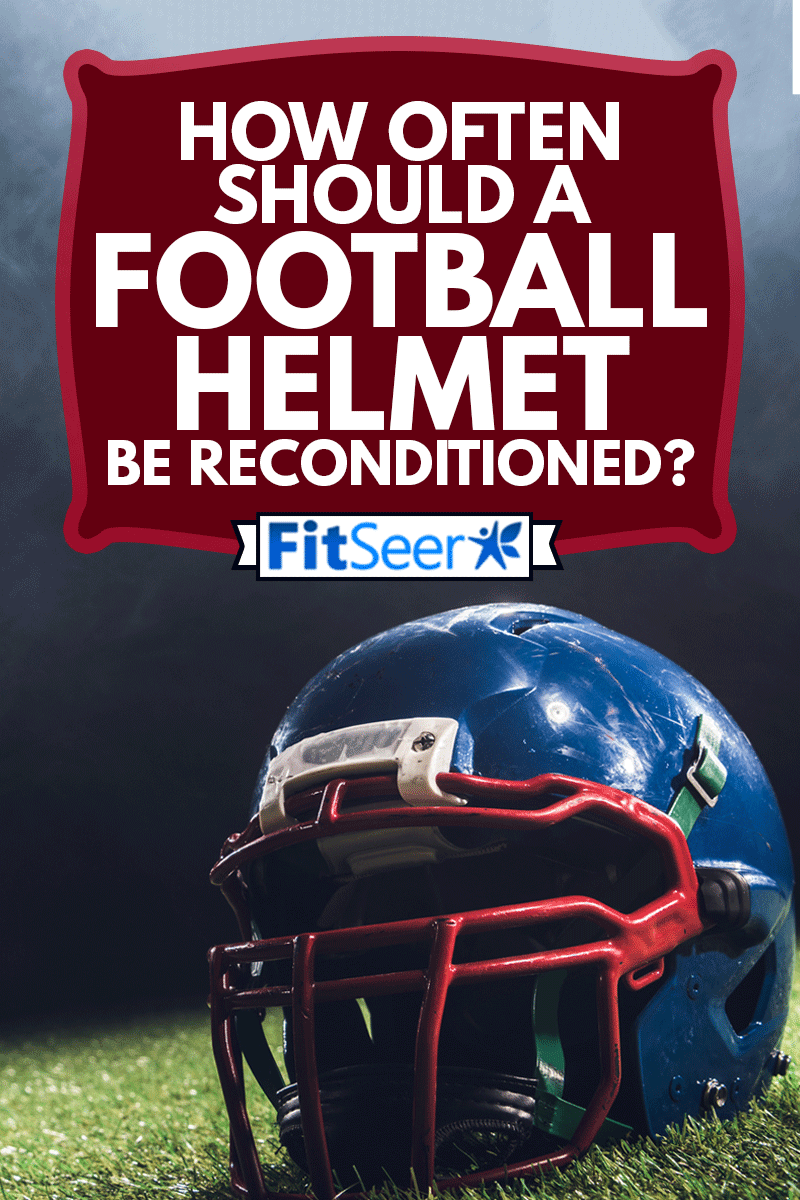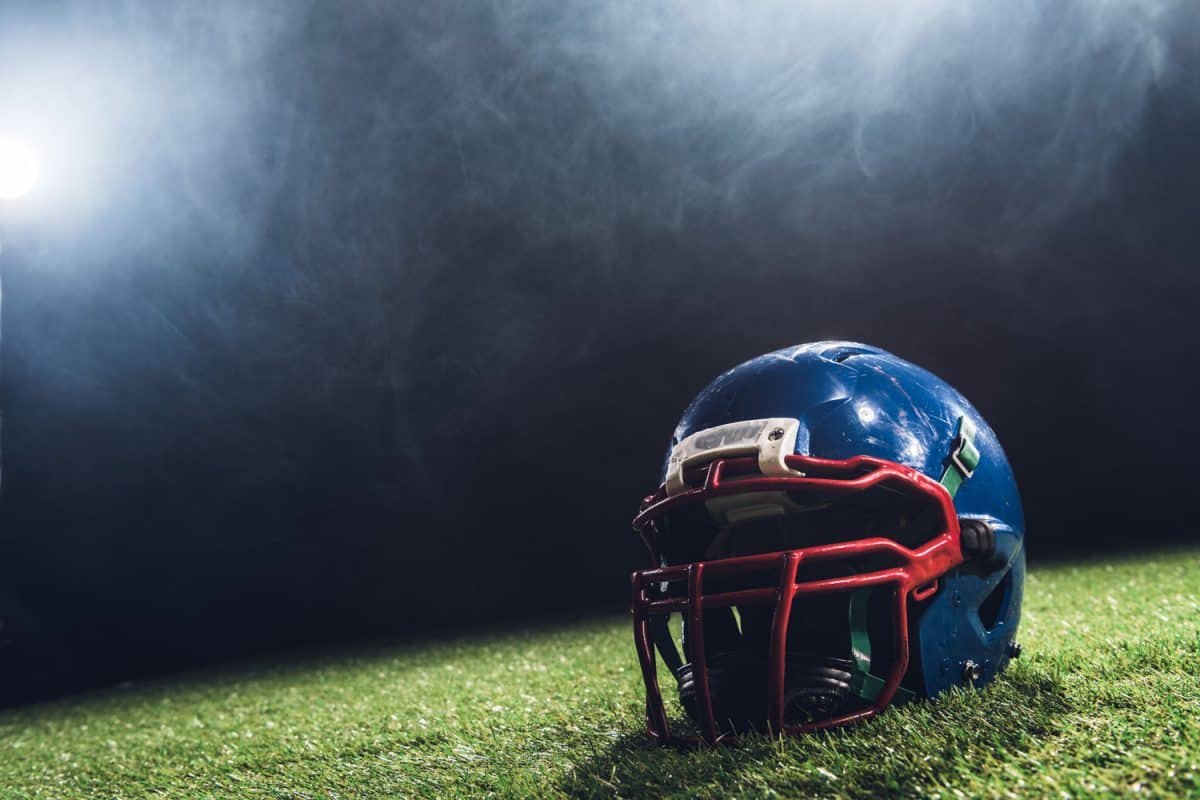Football helmets go through a lot of intense contact throughout a season. It can lead to scratches, chipped paint, dirt, and debris. With all that aggressive impact a football helmet often gets dealt, you'd likely wanna know how often it needs to be reconditioned. We've done the research and found the information you're looking for.
If you regularly play football, you should get it reconditioned every two full seasons. This helps keep your helmet in proper working order and shape.
Reconditioning your football helmet is an important, yet easy-to-forget, step in keeping you protected while you play. Continue reading to get in-depth knowledge on the process of football helmet reconditioning.

What Does it Mean to Recondition a Football Helmet?
For those of you unfamiliar with what reconditioning is, think of it as getting a tune-up for your helmet.
Throughout the season, the rough play of football will cause a little wear and tear in each game. You'll unknowingly get dirt, scratches, and possibly small dents. Even the protective support from the inside can wear down a little.
The more you play, the more susceptible the football helmet is to damage. To help prevent that, reconditioning exists.
Reconditioning a football helmet is a simple process. Just follow these steps:
- First, you take your helmet to an authorized reconditioner. Make sure you look for a retailer that's affiliated with the NAERA (National Athletic Equipment Reconditioners Association) and/or the NOCSAE (National Operating Committee on Standards for Athletic Equipment).
- Next, the reconditioner takes your helmet, places it in a bag, and stores it until it's time to recondition it. We'll talk about the wait time later.
- When it's time, the reconditioner takes the helmet for testing in its current state. Testing involves a drop test from a certain height to check its durability.
- After the test, reconditioners take apart the helmet, removing the facemask, decal, and hardware. Each part is examined for cracks, dents, and any other defects.
- Once everything is inspected and cleaned, the helmet shell goes through another drop test.
- If everything passes after the second drop test, all the refreshed parts are reassembled into the helmet.
After the reconditioning is finished, you get a nicely cleaned, reconditioned helmet to use for another two seasons. Depending on where you go, the reconditioner may place a date of when the helmet will need reconditioning again.
How Long Does it Take to Recondition a Helmet?
According to the National Sporting Goods Association, last year saw over 1.7 million helmets get reconditioned by NOCSAE licensed locations. You can imagine that it takes a while to recondition that many helmets, especially with the detailed process of reconditioning.
How long your helmet takes to get reconditioned will vary. The largest variable will be however many helmets a location has in their queue. However, you should be asked if you have a timeline of when you want the helmet back.
You can expect a football helmet reconditioning process to take anywhere between one to two weeks, and sometimes five weeks at some locations. If the location has a lot of helmets to recondition, that wait can extend for months. This is why you should list when you'd need it done to help expedite the wait.
How Much Does it Cost to Recondition a Football Helmet?
There is not one average price range to get a football helmet reconditioned. The websites of reconditioning locations will often ask you to fill out some information to get a quote. Prices will fluctuate based on a few factors.
The largest contributor is the number of helmets needing reconditioning. If one person needs one helmet reconditioned, you can expect to pay between $30 and $40 per helmet, according to USA Football. That price will go down per helmet if you need a full team's or league's helmets refurbished.
The price will also fluctuate according to the helmet size; is it kids-sized, youth-sized, or standard size?
How do you Certify a Football Helmet?

When you do your research on reconditioning, you will see the word "recertification" as well. It's easy to get the two terms confused. However, they're not the same thing.
In both cases, your helmet will go through some kind of testing. Reconditioning involves taking the helmet apart to test how good or bad each part is. Whatever parts don't test positive as effective will be replaced.
Recertification, however, tests the durability of the whole helmet. It's a step in the entire reconditioning process where the helmet gets tested before the process is started and after the process is finished. This testing is to ensure that the helmet still meets the same requirements as the original certification.
Recertification standards for helmets can be viewed by visiting this page on the NOCSAE official website.
Your football helmet will be certified once it passes testing. The test places a helmet on a synthetic head, then drops it from 60 inches 16 times from six different angles. Two more drops are done at high temperatures to see how the helmet handles high temperatures. The drops at this height from different angles simulate a player running at least 12 MPH into a flat surface.
Only one helmet out of a batch of similar helmets is tested.
How Much Does it Cost to Recertify a Football Helmet?
The cost to get your helmet recertified is part of the reconditioning.
Where can I get my Helmet Recertified?
If you visit the NAERA website, you can find locations that are members with them that offer football helmet reconditioning/recertification.
Many sports stores like Dick's Sporting Goods will offer these services as well. Riddell, a brand that sells football helmets, lets you place an order to ship your helmet to get recertified.
You don't have to go somewhere that's partnered with the NAERA, but we recommend you try finding a partner before going to a more convenient location. This is because of the history that the NAERA and NOCSAE share in ensuring the safety of athletes.
Do NFL Players get new Helmets Every Game?
For the last seven years, the NFL has had a rule saying that a team may only wear one helmet for the season; meaning throwback helmets couldn't be worn even if the uniforms were, according to this CBS Sports story.
Considering how each team practices and plays for multiple hours at least 17 weeks a season, you can imagine how much impact their helmets take.
Despite this, they don't get new helmets after each game. Every helmet gets replaced whenever it's needed. So if a helmet breaks and is unrepairable, then a player will get a new helmet. Otherwise, they will use the same helmet all season, touching up any scratches as the season goes on.
Recap

The integrity of your football helmet is important to maintain. Doing so provides you the maximum protection on the field. Getting your football helmet reconditioned regularly will not only ensure you keep a safe head but also saves you hundreds of dollars on the cost of a new helmet.
If you're concerned about footwear, not just headwear, check out two of our other posts to learn more:




![Read more about the article How To Add Grip To Basketball Shoes [5 Crucial Tips]](https://fitseer.com/wp-content/uploads/2020/09/A-high-school-basketball-player-dribbles-between-his-legs-with-his-basketball-shoes-grips-on-the-floor-500x333.jpg)

![Read more about the article What Do You Need To Play Squash? [The Ultimate Gear List]](https://fitseer.com/wp-content/uploads/2021/01/Player-with-squash-ball-and-racket-What-Do-You-Need-To-Play-Squash-The-Ultimate-Gear-List-500x333.jpg)